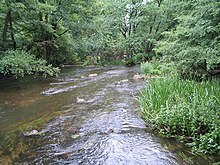Gravelly lowland river

The gravel-shaped lowland river (type 17) is one of the river types defined by the Federal / State Working Group on Water (LAWA) .
Water structure
The rivers mostly flow in wide and flat bottom valleys with numerous backwaters . They are winding to strongly meandering with mostly comparatively strong currents. Along with gravel, sand and stones also occur in the area of the river bed. The sediments are mostly sorted by the current, however, and sand and gravel banks form as well as pools and banks break off in places. Nevertheless, the transverse profile of the water is mostly flat.
The breakthrough valleys of the young moraine also belong to this type of flowing water because of their substrate and their current.
The catchment area of the gravel-shaped lowland rivers is larger than 100 km², which is how they differ from the gravel-shaped lowland streams .
Flora and fauna
Gravel-shaped lowland rivers are relatively species-rich. There are, for example, the ground bug , various caddis fly larvae or the river mussel . Among the fish, there are not only current-loving species such as brown trout and minnow , but also fish such as the roach , which tend to colonize the quieter areas of the river.
Plant growth is mainly present in the quieter areas. For example, the common hedgehog's cob , various red algae and other plants grow there . Plankton is also present in these waters.
Examples
swell
- Profile of the river type 17 on wasserblick.net (PDF; 164 kB), accessed on November 17, 2011
